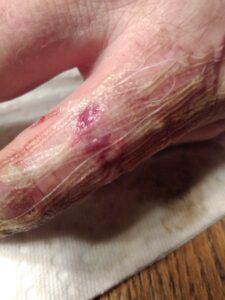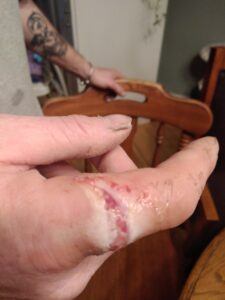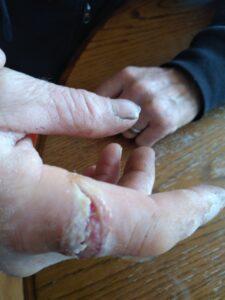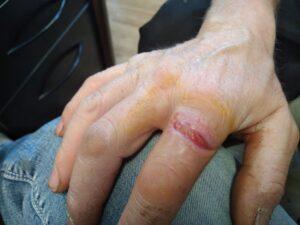Picture this. You’re knee-deep in your work on a bustling jobsite. The last thing on your mind? An injury. But, accidents happen. And when they do, it’s not just about the immediate pain. There’s the looming threat of infection. Nasty, right?
Well, here’s the silver lining. Preventing infections in open wounds might be simpler than you think. It’s all about the right knowledge and a pinch of preparedness. Let’s dive into some easy-to-follow steps that can keep you safe and speed up your recovery. Because, honestly, who has time for a setback?
Why Open Wounds Are Vulnerable to Infections on a Jobsite
Let’s face it. Jobsites are not exactly the epitome of clean. With dust flying, equipment everywhere, and hands getting dirty, it’s practically an invitation for germs. And, we are not even going to get into what porta potties normally look like. This is where the danger lies for open wounds.
The Germy Playground
First off, open wounds are like open doors. “Come on in,” they say to bacteria and viruses. On a jobsite, these uninvited guests are everywhere. From the tools you grip to the surfaces you touch. It’s a germy playground, and your wound might be the main attraction.
Dust and debris are more than just a nuisance. They can carry harmful microorganisms. When these particles find their way into a cut or scrape, they bring infections along for the ride. The big risk that not enough people are talking about is Community Acquired MRSA, and sepsis. Not exactly what you signed up for, right?
Moisture Madness
Now, let’s talk moisture. Sweating is part of the job. But those damp conditions are perfect for bacteria to thrive. Combine this with a wound, and you’ve got the perfect storm. It’s like throwing a bacteria party. And trust me, you don’t want to be the host.
Effective Cleaning Techniques to Prevent Infections
Alright, so we’ve established that jobsites can be a hotbed for germs, making open wounds vulnerable. But fear not! There are effective ways to clean those wounds and shield them from infections.
First things first, washing your hands is a game-changer. It sounds basic, but think about it. Your hands are your main tools. Before you even think about touching that wound, give your hands a good scrub with soap and water. This simple act is your first line of defense.
Clean Gently but Thoroughly
Now, onto the wound itself. Gentle cleaning is key. Use clean, running water and mild soap to carefully clean around the wound. Avoid getting soap directly in it, as this can cause irritation. This step helps wash away any dirt or debris that’s made a home in your wound. If you can, soaking in a container of water with a small amount of hydrogen peroxide helps.
After cleaning, pat the area dry with a clean towel or let it air dry. Rubbing can irritate the skin around the wound. And irritation is not what we’re aiming for here.
Disinfect Wisely
Time for a bit of disinfecting. But let’s not go overboard. Using a gentle antiseptic solution can help kill germs without harming your skin. Apply it carefully around the wound. Remember, the goal is to fight infection, not your skin. My disinfecting agent of choice is Betadine (iodine solution) and silver.
Lastly, keep it covered. A clean, breathable bandage can protect the wound from the elements and those pesky germs lurking on the jobsite. Change the bandage daily, or more often if it gets dirty or wet.
And there you have it! With these techniques in your back pocket, you’re well on your way to keeping those wounds clean and preventing infections. Because let’s be honest, nobody’s got time for that.
Proper Dressing and Protection of Wounds
Moving on, let’s chat about dressing and protecting those wounds. Because honestly, it’s a jungle out there, and your wound needs all the armor it can get.
Choosing the right dressing is like picking the perfect outfit. It has to fit well and be suitable for the occasion. For most cuts and scrapes, a sterile adhesive bandage does the trick. It keeps germs out and lets your skin breathe. Remember, a happy wound is one that can catch its breath.
Now, if your wound is a bit more like a party crasher—larger and more unwelcome—gauze and tape might be your go-tos. Wrap it snugly, but not like a python. You want to support healing, not cut off circulation.
Keep It Clean
Here’s a pro tip: Always change your dressing if it gets wet or dirty. A dirty bandage is like a germ party invitation. Take it off, clean the wound again gently, and put on a fresh bandage. This simple routine is your secret weapon against infections. If your bandage has stuck to the wound, gently soak it off.
Watch for Signs of Trouble
Let’s talk about keeping an eye on the healing process. Redness, swelling, and oozing are the unwelcome guests at the healing party. If you spot them, it might be time to consult a healthcare professional. They can crash the party and get things back on track.
In short, dress those wounds like you mean it. Use the right materials, keep everything clean, and stay vigilant. Your wounds will thank you with a speedy recovery, and you’ll be back to business as usual in no time. Because let’s be honest, you’ve got better things to do than nurse a wound.
Recognizing Early Signs of Infection in Wounds
So, your wound is all dressed up. But the story doesn’t end there. Let’s turn the page to something super important—spotting those sneaky signs of infection. Think of it as playing detective, but the clues are on your skin.
First off, warmth. I’m not talking about a cozy blanket. If your wound feels like it’s hosting a little heater, pay attention. Warmth can signal that your body is fighting unwelcome bacteria.
Next, redness. A bit of red around your wound at the start is normal. But if it starts to spread or gets more intense, that’s a red flag—literally. Your body is signaling SOS.
And oh, the swelling. A little puffiness is expected, but if your wound starts to look like it’s storing nuts for the winter, it’s time to take action. Swelling is your body’s way of saying, “I need backup!”
Don’t forget about pain. Yes, wounds can hurt at first. But if the pain escalates or just won’t say goodbye, it might mean infection has crashed the healing party. Homeopathic arnica can help with the pain, and swelling and work with silver to keep infection at bay.
Lastly, let’s talk ooze. Some clear fluid is normal, but if it starts looking like a scene from a gross-out movie, especially if it’s yellow or green, that’s a sign of infection.
In the end, knowing these early signs of infection can make a huge difference. It’s like catching a typo in an important email before you hit send. A little attention can save a lot of trouble. So keep an eye out, and let’s keep those wounds on the straight and narrow path to healing.
In the below photographs, I take you through the healing process of a severe wound. In this case, he caught his finger in a table saw, and took the meat to the bone. Bone and tendon was good, but the finger was terrible. In this case, we only had access to the care we could provide. No emergency room.








We used good butterfly and steri strips to close up the wound, and treated with betadine and silver bandages. Dressings were changed twice a day and it took 27 days for the wound to fill in, and heal. We had to do some debriding, but overall not too much. We kept the wound moist so that he could move it and stretch the skin. Today, he has a thin red line that remains and full range of motion. Not gonna lie, it was gruesome but if you follow the process, it will heal.
The Bottom Line: Ensuring Long-Term Wound Care Success
Here we are, at the end of our journey through the world of wound care. It’s been quite the adventure, hasn’t it? Let’s wrap it up with some key takeaways to ensure your wounds heal not just quickly, but properly too.
First things first, cleanliness is your best friend. Keeping your wound and its dressing clean can’t be understated. It’s like the golden rule of wound care. I have taken on some incredibly ugly wounds, and keeping it clean, using clean tools, and gloves is a part of good wound care.
Remember, your body is pretty amazing at healing itself, but it doesn’t say no to a bit of help. That means staying nourished and hydrated. Think of it as fueling your body’s repair team.
If something feels off, or if that wound isn’t looking happy, get it checked out. It’s better to be overcautious than overlook something serious.
And, patience, my friend. Healing is not a race. Give your body the time it needs to do its thing. Rushing it or getting frustrated isn’t going to speed up the process. If you have diabetes or an underlying medical condition, your healing will take longer.
Lastly, apply what you’ve learned. Next time you or someone you know gets a wound, you’ll be ready. Knowledge is power, especially when it comes to health.
So, there you have it. It’s not about getting through wound care; it’s about doing it right. By following these steps, you’re not just ensuring a swift recovery; you’re paving the way for long-term success. Thanks for sticking around, and here’s to healthy healing!
